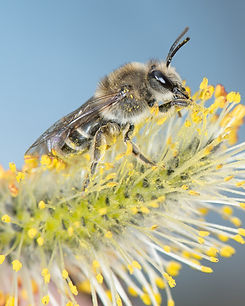
Family Megachilidae > Genus Dianthidium
Dianthidium
Pebble Bees
In Minnesota, there are three described species within the genus Dianthidium. Bees in this genus have solitary nests that are either belowground or aboveground. The aboveground nests contain multiple cells, are constructed with plant resins and pebbles, and are attached to rocks or other hard exterior surfaces. Of the three species that occur in Minnesota, Dianthidium simile is the only species that nests belowground in the fibrous roots at the base of native grasses in sand prairies. It also uses resins in the nest to bind together sand particles or pebbles. The remaining two, Dianthium pudicum and D. parvum construct aboveground pebble and resin nests. Dianthidium parvum is very rare; only one male has been found in the state (in 2020).
Dianthidium are robustly shaped, dark gray or black with white or yellow markings on their abdomen. Both males and females have three teeth on each mandible. Females collect pollen on hairs on the underside of their abdomen. Bees in this genus range in length from 5 to 12 mm (0.2 to 0.7 inches). The species in Minnesota range in length from 7 to 9 mm.

Dianthidium simile visiting Liatris aspera.

wing
position
on flowers

N0. species in MN
3
size range

Phenology

Genus Characteristics

Translucent edge on pronotal lobes.

Face of propodeum vertical.

Two submarginal cells; the 2nd recurrent vein extends beyond the 2nd submarginal cell.
1
2

Black integument with white or yellow markings; robust shape.
Distribution

Dianthidium parvum

Dianthidium pudicum

Dianthidium simile
Portman et al (2023)
Additional Record
Dianthidium Species in Minnesota
Scientific Name | Nest | Likely Lecty | Host |
|---|---|---|---|
Dianthidium parvum | aboveground, resin and pebbles | oligolectic | Cirsium, Erigeron, Heterotheca, Gaillardia, Grindelia, Xanthisma (Machaeranthera) |
Dianthidium pudicum | aboveground, resin and pebbles | oligolectic | |
Dianthidium simile | ground, in grass roots | oligolectic | Helianthus (Arduser), Solidago, Symphyotrichum |
Source: Minnesota Department of Natural Resources, Minnesota Bee Species List (August 2023).
https://files.dnr.state.mn.us/eco/mcbs/mn-statewide-bee-list.pdf

Dianthidium simile visiting Heterotheca villosa
Explore More Megachilidae Genera
Note: Two genera/species on the state list are not included in this guide: Ashmeadiella bucconis (last seen in Minnesota in 1949) and Trachusa zebrata (last seen in Minnesota in 1939). If either of these species is rediscovered in the state, they will be added to the guide at that time.
Explore Bee Families

Apidae
15 genera, 133 species
Bumble bees Bombus
Longhorn bees
Epimelissodes, Eucera, Melissodes
Carpenter bees
Ceratina, Xylocopa
Honey bees Apis
Digger bees Anthophora
Cuckoo bees Brachymelecta, Epeolus, Holcopasites, Nomada, Neolarra, Triepeolus
Squash bees Xenoglossa

2 genera, 39 species
Halictidae
10 genera, 133 species
Metallic green sweat bees
Agapostemon, Augochlora, Augochlorella, Augochloropsis
Large sweat bees
Dieunomia, Nomia
Short-faced bees Dufourea
Sweat bees Halictus
Small sweat bees Lasioglossum
Cuckoo (blood) bees Sphecodes
Megachilidae
14 genera, 86 species
Resin and pebble bees Anthidiellum, Dianthidium, Heriades, Paranthidium
Carder bees Anthidium, Pseudoanthidium
Mock orange bees Chelostoma
Mason bees Osmia, Hoplitis
Leafcutter bees Megachile
Sharp-tailed cuckoo bees Coelioxys
Dark cuckoo bees Stelis

Citations and Further Reading
Droege, S., et al. (2024). The Very Handy Bee Manual: 2.0. How to Catch and Identify Bees and Manage a Collection.
Hicks, C. H. (1927). Parasites and habits of Dianthidium pudicum Cresson. Psyche: A Journal of Entomology, 34(6), 193-198.
Gibbs, J., Hanuschuk, E., Miller, R., Dubois, M., Martini, M., Robinson, S., ... & Onuferko, T. M. (2023). A checklist of the bees (Hymenoptera: Apoidea) of Manitoba, Canada. The Canadian Entomologist, 155, e3.
Gibbs, J. (2017). Notes on the nests of Augochloropsis metallica fulgida and Megachile mucida in central Michigan (Hymenoptera: Halictidae, Megachilidae). The Great Lakes Entomologist, 50(1), 4.
Mitchell, T. B. (1960). Bees of the eastern United States. Technical Bulletin No. 141. North Carolina Agricultural Experiment Station.
Portman, Z. M., Gardner, J., Lane, I. G., Gerjets, N., Petersen, J. D., Ascher, J. S., ... & Cariveau, D. P. (2023). A checklist of the bees (Hymenoptera: Apoidea) of Minnesota. Zootaxa, 5304(1), 1-95.
Portman, Z. M., Arduser, M., Lane, I. G., & Cariveau, D. P. (2022). A review of the Augochloropsis (Hymenoptera, Halictidae) and keys to the shiny green Halictinae of the midwestern United States. ZooKeys, 1130, 103.
Wilson, J. S., & Messinger Carril, O. J. (2016). The bees in your backyard: a guide to North America's bees. Princeton University Press.
Page Photography Credits
Heather Holm















